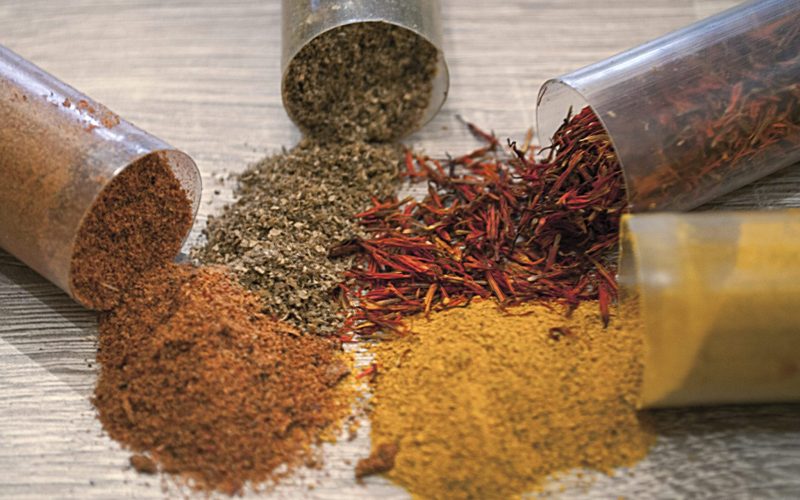Italian seasoning is one of those pantry staples you should have but hasn’t thought about in years.
It’s a great way to add subtle flavor and depth to your meals, but also one that you probably don’t think about changing unless there’s an exciting new spice or herb on the market.
But what are the substitutes for Italian seasoning? We’re here to help!
In this post, we’ll explore substitutes for Italian seasoning—from curry powder (which works well with heavy meats like chicken) to oregano (which can be replaced with thyme or basil); we’ve got you covered one way or another.
1. Curry Powder
Curry powder is the first on our list of substitutes for Italian seasoning.
It is a blend of spices, including turmeric, coriander, cumin, ginger, garlic, and sometimes nutmeg or fenugreek. The blend may also contain red or black pepper flakes for added heat.
The idea behind curry powder is that it can be used as a substitute for Italian seasoning.
It does have some of the same spices as Italian seasoning (such as oregano).
Still, there are differences between them too: Curry powder has more depth than Italian because each ingredient contributes its flavor profile, whereas, in Italian, you’ll get all the herbs together.
Still, none stand out individually as with curry powder–which makes sense since they’re blended!
Because it’s a blend of spices, curry powder is very versatile. It can be used in various dishes and added to almost any type of food.
You can use it as an ingredient in one-pot curries or the base for other sauces, stews, and soups.
The spice mix can be used as a marinade for meat or fish or added to vegetables before roasting.
You can also use it in stir-fries and stews. Curry powder is a blend of herbs and spices originating in South Asia.
It’s made from various spices, including turmeric, cardamom, ginger, and cumin.
When it comes to cooking, curry powder is a very popular ingredient. It can be used in various dishes and added to almost any type of food.
You can use it as an ingredient in one-pot curries or the base for other sauces, stews, and soups.
The spice mix can be used as a marinade for meat or fish or added to vegetables before roasting. You can also use it in stir-fries and stews.
The spice mix can be used as an ingredient in one-pot curries or the base for other sauces, stews, and soups.
The spice mix can be used as a marinade for meat or fish or added to vegetables before roasting. You can also use it in stir-fries and stews.
Curry powder is a blend of herbs and spices originating in South Asia.
It’s made from various spices, including turmeric, cardamom, ginger, and cumin. When it comes to cooking, curry powder is a very popular ingredient.
2. Oregano
Oregano is the next on our list of substitutes for Italian seasoning. It is a spice that comes from the Mediterranean region.
It has a strong flavor and aroma, and it’s often used in Italian, Greek, and Mexican dishes.
Oregano can also be found in soups or stews. Oregano is common in many Italian dishes, including pizza and spaghetti sauce.
It’s also used to season meat and fish. Oregano is often used to flavor soups, stews, and Mexican dishes.
It’s also common in pizza, spaghetti sauce, and many Italian dishes.
Oregano can be used as a garnish on salads or with vegetables like artichokes or tomatoes.
It’s often used to season meat and fish but is commonly combined with other herbs like thyme, rosemary, and marjoram.
Oregano is a versatile spice that can be used in many different dishes. It’s often used to season meat and fish but can also be found in soups or stews.
It is common in Italian cuisine, pizza recipes, and Mexican dishes like fajitas and tacos.
Oregano can be used to season meat and fish, but it’s also commonly combined with other herbs like thyme, rosemary, and marjoram.
It is a versatile spice that can be used in many different dishes. It’s often used to season meat and fish but can also be found in soups or stews.
Oregano is common in Italian cuisine, pizza recipes, and Mexican dishes like fajitas and tacos.
Oregano is a versatile spice that can be used in many different dishes. It’s often used to season meat and fish but can also be found in soups or stews.
This is common in Italian cuisine, pizza recipes, and Mexican dishes like fajitas and tacos.
Oregano can be used to season meat and fish, but it’s also commonly combined with other herbs like thyme, rosemary, and marjoram.
This is a versatile spice that can be used in many different dishes. It’s often used to season meat and fish but can also be found in soups or stews.
Oregano is common in Italian cuisine, pizza recipes, and Mexican dishes like fajitas and tacos.
Oregano is a versatile spice that can be used in many different dishes. It’s often used to season meat and fish but can also be found in soups or stews.
3. Thyme
Thyme is a perennial herb that will come back every year. It can be used in cooking and herbal teas.
It is also used to make a type of wine called vermouth. The entire plant is edible, and it has a mild flavor.
The leaves are used in salads or cooked like spinach. They can also be dried and stored for later use.
The leaves are high in vitamins A and C. They also contain many minerals like calcium, iron, magnesium, potassium, and zinc.
The flowers have a delicate flavor that is slightly sweet and nutty.
They can be used in salads or cooked like spinach. They have a mild flavor and are high in vitamins A and C.
The flowers are also high in antioxidants, which help to protect cells from damage.
The flowers are also high in minerals like calcium, iron, magnesium, potassium, and zinc.
The plant’s roots have a mild flavor that is slightly sweet and nutty. They can be used in salads or cooked like spinach.
They have a mild flavor and are high in vitamins A and C.
The roots are also high in antioxidants, which help to protect cells from damage. The bulbs are used in cooking and herbal teas.
They have a mild flavor and are high in vitamins A and C.
The bulbs also contain calcium, iron, magnesium, potassium, and zinc minerals. The bulbs are used in cooking and herbal teas.
They have a mild flavor and are high in vitamins A and C. The bulbs also contain calcium, iron, magnesium, potassium, and zinc minerals.
The plant’s roots have a mild flavor that is slightly sweet and nutty. They can be used in salads or cooked like spinach.
They have a mild flavor and are high in vitamins A and C. The flowers are also high in antioxidants, which help to protect cells from damage.
4. Basil and Parsley
Basil and parsley are commonly used in Italian cooking. Basil is a leafy green herb that has a sweet taste, while parsley is also a leafy green herb with a milder flavor than basil.
You can use either of these herbs as the primary ingredient or as an addition to your dish.
The best way to add herbs to your dish is by using fresh herbs. You can purchase them at any grocery store or even grow them if you have enough space in your garden.
If you don’t have fresh herbs, dried ones will also work. When using herbs, it’s important to remember that they are very strong in flavor.
This means that you should use them sparingly and add more as needed instead of overdoing them right away.
If you don’t like the taste of an herb or don’t have access to it, then feel free to substitute it with another herb with similar properties but a milder flavor.
For example, if you don’t like the taste of parsley, then try using basil instead. Both herbs have similar properties, such as helping lower blood pressure and cholesterol levels.
However, they have different tastes—basil has a sweet flavor, while parsley is milder.
When using herbs in your cooking, it’s important to remember that they are very strong in flavor.
You should use them sparingly and add more as needed instead of overdoing them immediately.
If you don’t like the taste of an herb or don’t have access to it, then feel free to substitute it with another herb with similar properties but a milder flavor.
For example, if you don’t like the taste of parsley, then try using basil instead. Both herbs have similar properties, such as helping lower blood pressure and cholesterol levels.
However, they have different tastes—basil has a sweet flavor, while parsley is milder.
When using herbs in your cooking, it’s important to remember that they are very strong in flavor.
You should use them sparingly and add more as needed instead of overdoing them immediately.
If you don’t like the taste of an herb or don’t have access to it, then feel free to substitute it with another herb with similar properties but a milder flavor.
For example, if you don’t like the taste of parsley, then try using basil instead. Both herbs have similar properties, such as helping lower blood pressure and cholesterol levels.
However, they have different tastes—basil has a sweet flavor, while parsley is milder.
Takeaway
Use it as-is to cut back on salt and have a favorite Italian seasoning blend.
If not, many other options can be substituted for it.
- Mix 2 tablespoons of dried basil leaves with 1/2 teaspoon each of black pepper and crushed red pepper flakes. This is a good substitute for 1 tablespoon of granulated garlic powder.
- Combine 2 teaspoons of dried oregano leaves with 1 teaspoon of dried thyme leaves in a small bowl (about 1/4 teaspoon each). This makes the equivalent amount as 3 teaspoons of granulated garlic powder or one tablespoon of granulated onion powder when mixed into dry ingredients such as flour or breadcrumbs at low speeds using an electric mixer on medium speed until combined well before going too far into high speeds where they might separate too much moisture during the baking time – this could result in uneven baking results if done improperly so consult your local cookbook first before attempting anything new like this!
If you’re looking for a substitute for an Italian seasoning blend in baked goods, add 1/4 teaspoon each of garlic powder, onion powder, and ground black pepper to the recipe.
This will make up the equivalent amount of 1 tablespoon of granulated garlic powder or one tablespoon of granulated onion powder.
You can also try adding 1/4 teaspoon each of garlic powder, onion powder, and ground black pepper to the recipe.
This will make up the equivalent amount of 1 tablespoon of granulated garlic powder or one tablespoon of granulated onion powder.
If you’re looking for substitutes for Italian seasoning blend in baked goods, add 1/4 teaspoon each of garlic powder, onion powder, and ground black pepper to the recipe.
This will make up the equivalent amount of 1 tablespoon of granulated garlic powder or one tablespoon of granulated onion powder.
You can also try adding 1/4 teaspoon each of garlic powder, onion powder, and ground black pepper to the recipe.
This will make up the equivalent amount of 1 tablespoon of granulated garlic powder or one tablespoon of granulated onion powder.
Conclusion
Substitutes for Italian seasoning are pantry staples you know you should have but haven’t thought about in years.
We hope this list has given you ideas on using Italian seasoning. If you’re looking for more recipes, we hope this article has helped.








